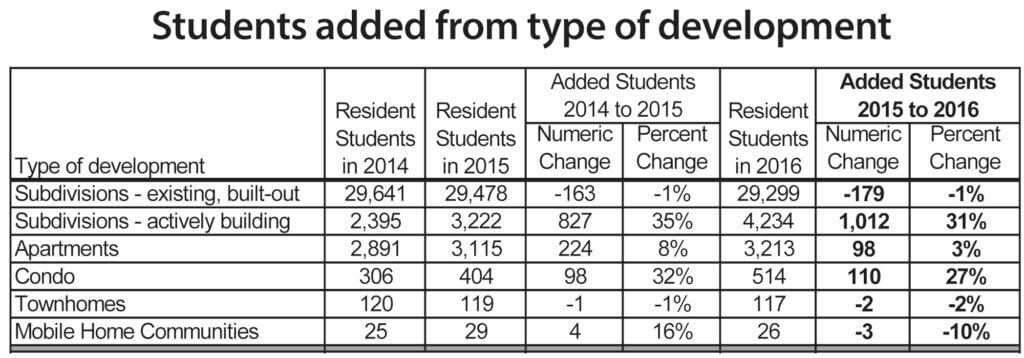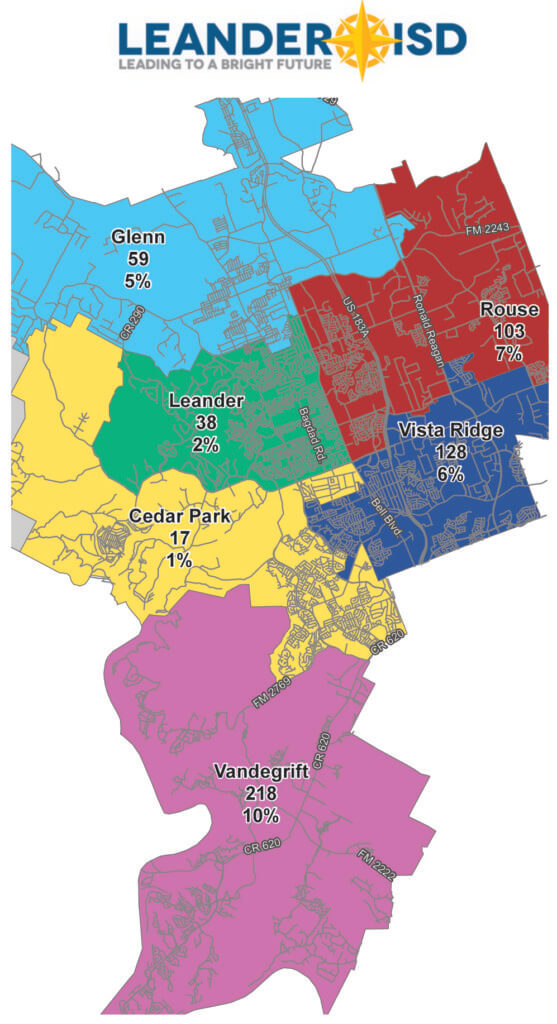Part II of demographer’s report
By MIKE EDDLEMAN
Hill Country News
While growth is fast and somewhat predictable on the north end of Leander ISD, it is a little more tricky on the southern end of the district.
“The vast majority of the growth is in the northern part of the district in Leander, but there’s still some growth in the south and very limited growth in the middle or Cedar Park area of the district,” said Superintendent Dan Troxell, discussing the growth issues facing the district.
Two factors that could play a role in future growth and planning in the central and southern portions of the district are essentially flat kindergarten enrollment – which is up on some campuses but down on others – and the increase in multi-family housing in the district.
Flatter kindergarten enrollment
Demographers pointed out in their annual presentation that because there were not as many “starter” homes being built today, the district was not necessarily drawing as many young families, but that the student increases would continue.
The mature neighborhoods in the central part of the district are also not regenerating at a high rate yet, meaning families that once had school-aged or younger children do not necessarily anymore. Also those families are not moving out to allow new families with school children to move in.
“We’re going to have to watch the demographic numbers over the next four years to see if the trend (demographers) pointed out in the heart of the district actually go down,” Troxell said. “They are saying they are having a much more difficult time saying when that will occur and when the rejuvenation of those neighborhoods will happen or if at all.”
Increase in multi-family units
While the older neighborhoods mean a potential dip in student population in some areas of the district, the increase of multi-family units opens the door to a sudden increase as well.
If there is a need for a new campus in the middle part of the district, there is a site LISD already owns.
There are 2,144 new multi-family units set to be available in the next two years alone, across nine developments. The challenge with multi-family units, according to demographers is there is usually a corresponding increase in the number of school-aged children in that smaller area versus single-family homes.
Campus balance
If the growth does not continue and campus populations decrease, Troxell said there are a number of options for coping with the new imbalance across campuses.
“You can create programs such as magnet high schools or even magnet middle schools to attract kids into an area where enrollment is declining even though overall enrollment is growing,” he said, adding that on the fringes of the district, the option is also there to open particular campuses to transfer students from other districts, but that would be looked at on a campus-by-campus basis.
Attendance lines
One option that often comes up as student populations shift is redrawing attendance lines, but Troxell said that is a last resort for a few reasons.
It often becomes more costly to bus students past one campus to attend another. He added that in some cases, it would be preferable for the number of students to drop.
“Quite frankly, some of our schools need to come down in size because they are over-enrolled,” Troxell said. “So I don’t think you are going to see mass rezoning as an option. It’s not just a political issue, it’s a financial issue.”
Beyond cost, though, Troxell said the community focus of LISD campuses is something the administration doesn’t want to jeopardize.
“This district has really embraced the idea of neighborhood schools,” he said. “One of the things I’ve found as an outsider coming in over the last eight weeks is that Cedar Park has a community and spirit at their high school. You see it on Friday nights at volleyball matches, you see it at football games. Then I go to Vandegrift and I see that same thing. All of our schools have a really nice community feel. When you start bussing kids across boundaries to fill schools you lose that.”
Annual scrutiny
While growth numbers have remained steady for years, LISD knows that it is an inexact science and must be monitored closely.
“You have to really look at the numbers and have those come back annually,” Troxell said. “This demographer is incredibly good, but what you can’t anticipate sometimes is a financial collapse like happened in 2009, or you can’t predict the kind of world events like from Sept. 11, 2001.”
Projections
At a projected low-growth rate, LISD – which currently has about 37,000 students enrolled – is expected to have more than 45,000 students by 2026. If growth continues on a faster pace it could top 53,000.
If projections hold, LISD will build five new elementary schools by 2024 after campus 26 opens next fall. Two middle schools would follow between 2020 and 2024 and a seventh high school in 2024 or 2025. Funding and plans are not in place for any campuses beyond the new elementary school currently under construction, and all projections are based on trends at this point.
Part I coverage of the 2016 demographer’s report is in the Nov. 9 edition.


